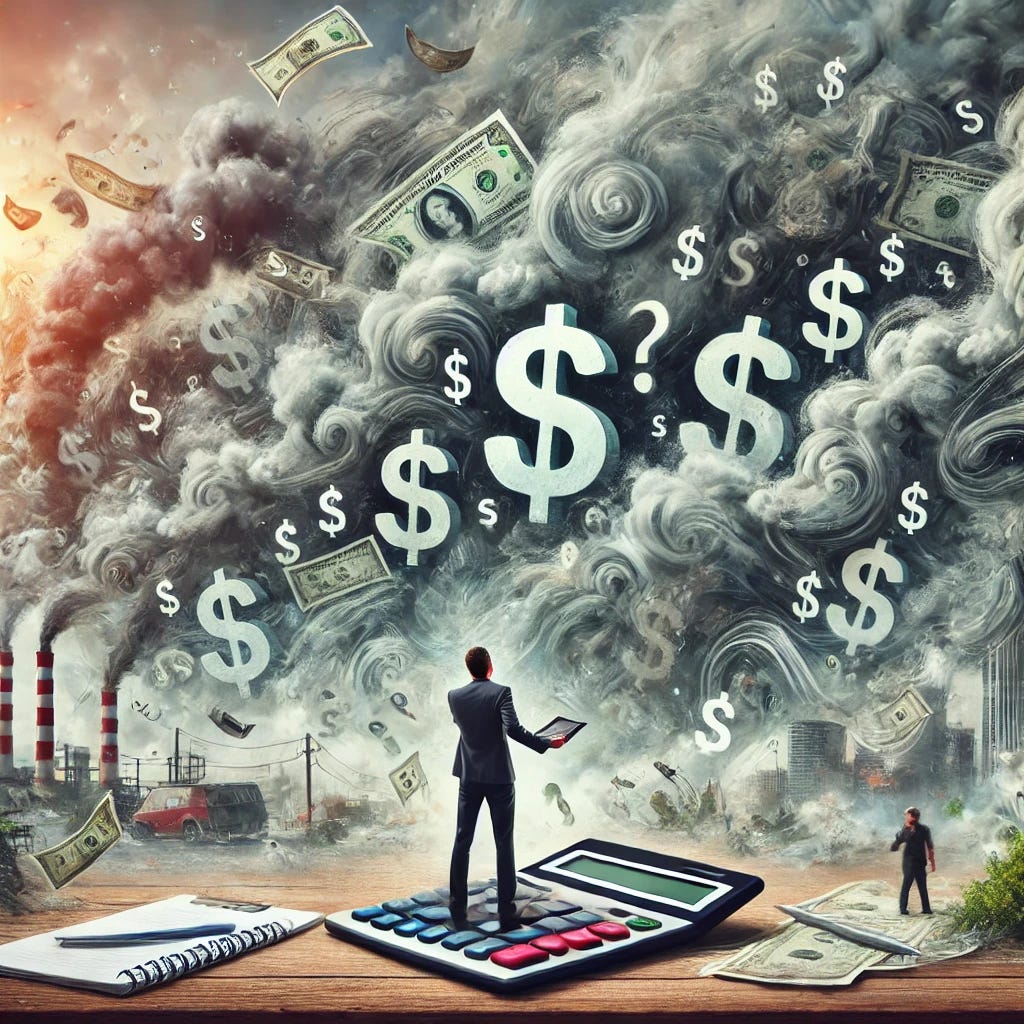Climate change, and policies to mitigate the consequences of climate change, are real issues. People can disagree with how we deal with it, the nature of coordination around the issue, and even in expectations of the severity of change and the consequences of mitigation tools - but climate will change and patterns of economic and social activity will adjust irrespective of how much we all yell at each other.
Now I’m sure many of you know more about the specifics than I do - as I don’t know much about anything. For this reason I’d be keen to hear your thoughts and learn from your perspectives and experience.
tl;dr this is a long post as I’m starting from the start. The conclusion is essentially that carbon pricing is good, there can be an argument for investment subsidies and education, and there are going to be distributional outcomes that can be dealt with through the revenue from carbon pricing and thoughful policies for those experiencing job loss.
Ultimately, carbon policy is a form of insurance - and the goal is to lower the cost, and share the burden, of negative outcomes associated with human induced climate change. As a result, we have the policy tools and knowledge to deal with it.
Carbon pricing and dividends
A “carbon price” is a tax based on the carbon content of a given activity. It doesn’t matter if we are levying the tax during production or at consumption, the goal is to make sure that the production of carbon is priced.
The logic here is an externality. A buyer and seller don’t care if there is carbon produced, they just want to trade. However, their decision to produce and trade is generating carbon which has a negative externality. So lets price the thing!
Now the purpose of this pricing is not to “stop climate change” - it is to ensure the social costs of climate change are priced, so that the choices made take them into account.
But what do we do with this revenue? Logically, if the costs of climate change are in the future it would make sense to build up a soveriegn wealth fund that will be used to meet the cost of future climate change events.
This also shows the relation between a carbon price and insurance markets for individuals managing their personal climate risk.
However, there may be political reasons why such a wealth fund is unsustainable, which in turn undermine the carbon tax. As the main purpose of the carbon tax is to make individuals internalise the full social cost of their production and consumption activities now we may recycle revenue in a less direct way to improve buy-in.
This is what Canada has done with the carbon dividend.
You may wonder how a carbon tax could be effective if it takes money and just gives it back to people. But it is important to remember that there are high and low carbon ways of producing and spending. By introducing a carbon tax and then returning an income payment to people, you are incentivising them to substitute to low carbon ways of production and spending.
Now carbon tax alone isn’t everything. If there are outcomes we already agree are socially insured, or that private individuals may under insure (such as flood risk, health challenges), then it will be important to make sure that government tax and spending policy is robust to these shocks. Again, the “right” carbon tax doesn’t stop climate change from happening at all - it makes sure the costs and benefits of climate change inclusive of the activities we all enjoy are balanced.
Anyone telling you climate change needs to be 100% reversed, or 100% ignored, is not advocating what is in the best interests of everyone in society - they are designing a crisis (be it climate change, or some made up concern about a world government) to give themselves a purpose in life.
Uncertainty
But we should price the social cost of carbon - something that isn’t easy, and requires an admission that some of what we will do is essentially insurance in an uncertain world.
Here there is then a debate between cap and trade (emissions trading schemes) vs carbon tax policies. An emissions trading scheme (ETS), like the one in New Zealand, has the advantage of “quantity certainty”. A carbon price has the benefit of “price certainty”.
When we use an ETS we have more control over the path of carbon, and the price that is set will in turn represent the social cost of us varying from that carbon path. When we are concerned with climate outcomes that become more uncertain away from this path this feels better.
However, it does involve greater uncertainty for the firm in terms of their investment decisions! As a result, when authors talk a lot about uncertainty they are imagining a world without a fixed carbon price and instead either an ETS or a “discovery process” around the right carbon price.
When determining what policy mix to have, the type of uncertainty we have is then important.
Mitigation and coordination
Does a carbon tax in Australiasia mitigate climate change. No - it won’t change anything. Would a global carbon tax mitigate climate change - yes. This is a coordination game.
Sometimes people use this argument to say “why are we hurting ourselves by pricing carbon when it makes no difference”, or “we are doing a policy that forces us to make things in a more expensive manner to benefit everyone - it isn’t fair”.
Sure. We also drive on the left-hand side of the road in Australia to avoid crashing into each other, even though sometimes the right-hand side looks nicer. In a world where our actions are interdependent, sometimes you have to try to coordinate with everyone else.
The goal in this post is to understand the best set of policies that all governments would coordinate on together. And even if you only want to think about your nation, a lot of us have signed up for the Paris Agreement which has internalised these carbon costs from the global to national level - they are on our government books now, so we need to find the best way to fund them.
Capital frictions and supply policies
Imagine we have a fixed carbon tax in place that we know meets the external costs of carbon use, insurance markets are safe, and we’ve invested in public infrastructure that will make sure humanities future will continue to be plentiful.
But could we have done anything better?
Investment choices are complicated. With uncertainty about future outcomes, uncertainty about policy, prior and future investments that are both “sunk” into a certain production process, and spillovers in terms of knowledge about mitigation technology.
This leads in the policies around green finance, investment incentives, and bans around certain production processes for firms.
Spillovers
If I work out a new production process that uses less carbon I gain the benefit from the carbon tax.
But say it cost me $10m to discover this idea, and I save a net $8m in carbon taxes. I won’t bother. But if I discover the process and everyone takes it on, there would be much larger savings overall. As these savings reflect the internalised social value of carbon, this is a more efficient way of mitigating the costs of climate change.
So we’d like these spillovers to be taken into account when people undertake innovative activities.
With standard R&D we would handle this with finite life patents - which would incentivise individuals to invest in the technology and then rent it out to other firms.
How does this differ from a standard R&D problem? For the most part it doesn’t - the key distinction is that the public desire to insure against extreme negative outcomes may differ from the private incentive to adjust policy.
This is really a question of where to set the carbon price - in this case the price sets a certain cost from producing carbon for firms, and they will adjust on that basis if they have the same ability to set up property rights through patents. It may be the case that we have incomplete markets and this new technology will not be traded - which as with the standard R&D literature suggests helping to set up such markets.
There is nothing here that requires a subsidy, until …
Sunk capital
This is an interesting one, and does assume firms tend to get stuck in certain productive processes that they will be reluctant to change.
A firm generates output by combining a variety of capital, labour, and technology. This process can be carbon intensive or not, and they will have built up this stock of productive technology and processes based on historic incentives.
If the relative price of carbon suddenly changes the relative price of this existing stock will slump - and there will be an incentive to change the process through time. However, such transitions are difficult - so old, carbon intensive, production processes can remain embedded within firms.
You may have heard of such putty-clay models with reference to the growth of West Germany and Japan post-WWII. The destruction of prior productive processes allowed firms to immediately focus on implementing fronteir technology, allowing for rapid growth.
Either due to spillovers, or behavioural inefficencies by firms, there may be a “slow” adjustment to carbon pricing which is inefficient in a welfare sense - here subsides to take up new efficient capital and production processes could be motivated.
Now at this stage people start arguing about whether to have expenditure subsidies, production subsidies, loan guarantees, banks and monetary authorities that treat investments differently blah blah blah. I’m just going to trust the expert economists and finance people who understand why such schemes are necessary to design policies that appropriately consider trade-offs - all I want to understand is the above argument for why such a subsidy was even needed, and hence how I can evaluate it when needed.
What is the scope for subsidising demand
This is a third category that keeps coming up “subsidise demand”. Make it cheaper for me to buy electricity from a green provider, pasta from an accredited green producer, or instead “buy goods locally” because the carbon content is probably lower right.
These arguments generally feel a bit bunk - as they are indirect and possibly corrupt versions of carbon pricing, that have a fiscal cost that substitute from other uses of government funds.
The key area where a demand policies are seen as relevant is when other policies haven’t been tried. In the paper we discussed earlier, in areas with dirty power grids where there was no pricing of carbon, price incentives to reduce energy consumption had a significant impact.
However, this is not a subsidy of demand. This is a policy implementing something like looks like a carbon tax to get people to reduce a specific form of consumption of a carbon creating activity.
The closest I’ve seen to a coherent discussion of this was the recent OECD discussion of “demand based” policies. I can summarise these as:
Do what are essentially supply based policies for household as well (i.e. subsidising solar panels),
Use payments to households to increase buy-in to carbon charges and help the transition for vulnerable households (the dividend payments with carbon taxes noted above),
Provide information to households,
In infrastructure (i.e. transport) make sure there are low carbon alternatives households could substitute to.
What about workers?
Workers are important when thinking about this for two reasons:
When mitigation tools are put in place certain workers will be the people most affected - or put in the most vulnerable position - following this.
If mitigation is imperfect there are many workers and households who will have struggled to self-insure against the climate shocks that follow - and support for these individuals will be important.
In fact - a lot of current thinking about the green transition is not “how do we achieve carbon targets”, but “what are the full set of outcomes of achieving these targets and how can we ensure this is fair”.
Job displacement work by e61 and the OECD has both shown that job loss for those in high emission industries tends to end up with large wage declines than for other workers - pointing to something negative happening with the job opportunities of those workers (more discussion here).
Social support programs represent the way we try to help those who experience a shock to get back on their feet, and to share the costs of this shock more broadly.
It is better we recognise that such shocks exist, and try to help those that are most harmed, instead of ignoring the shocks because “we really need to do climate things”. When we do that we both hurt truly vulnerable individuals, and we destroy internal buy-in for climate mitigation policies which will lead to even worse outcomes.
Everything about climate change mitigation is about insuring society against a future cost that we know is going to be negative - but have uncertainty about how negative it is.
Good policy will lower these costs where possible, and insure those who are most affected by the shocks - put this way, the purpose of policy isn’t complicated.
But these shocks are no different to any economic and social shock that may lead to certain individuals ending up in a difficult situation. As a society we should demand government policy that helps transitions - green or not - lifting up those who end up vulnerable due to the climate transition irrespective of the reason.












Climate tech VC here. A few thoughts and reactions:
- Personally, I don't think about it in insurance terms (where money can make good for a loss). For things like the Great Barrier Reef, a superorganism which took 20k years to grow, it's effective irreplaceable and it would be a permanent loss if it died. And morally I look at it as both from the perspective of humans enjoying it and the thing in itself being live and having a moral right to live. For me, Pindyck's paper falls down in conflating the costs of climate change with its GDP-measurable impacts and overstates the uncertainty of climate change impact.
- A carbon price would have been incredible effective at shifting corporate behaviour, if it had been brought in under the Waxman-Markey bill of 2009 or even better during the "neoliberal" 1990s. That's because boards would have seen the low but rising carbon price and made rational changes to investment decisions. Instead we have a system where boards have adopted "Net Zero by 2050" strategies to satisfy shareholders (which is still better than nothing) but the economically rational strategy in the short term is to satisfy this by doing pilots and other forms of greenwashing.
- In my view the best use of carbon revenue is to lower corporate and personal income taxes. That's because I think the deadweight costs of these taxes are quite high.
- For emissions intensive export commodities, such as natural gas, it's a tricky problem. Using gas to heat homes is bad, but using gas for peakers is good because a small amount of peaking gas can firm a large portfolio of wind, solar and batteries. But if you export gas to Japan (say), you can't really dictate what they do with it.
- The market is like a super brain for co-ordinating many actors, but sometimes firm long-term planning is required (think about it from the point of view of financing a wind farm - you really want certainty as to how much grid capacity will be available in the future to carry your electrons to market). It would be very helpful for one oerson to be "In Charge" of and accountable for making sure decarbonisation is achievable within the desired timeline. This means determining what the grid would optimally look like for a low cost renewables world, and making sure the key structural elements get built (even using eminent domain etc). There's a lot of uncertainty about the size of future demand so you need scalable solutions.
- Subject to the grid being in the right spot, transition costs to a net near zero economy need not be very expensive. Solar, wind, batteries, EVs, heat pumps are all cheap and getting cheaper.